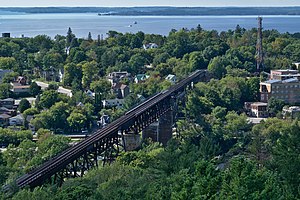Parry Sound CPR Trestle
Coordinates: 45 ° 20 ′ 27 ″ N , 80 ° 1 ′ 58 ″ W.
| Parry Sound CPR Trestle | ||
|---|---|---|
| use | Railway bridge | |
| Crossing of | ||
| place | Parry Sound in Ontario , Canada | |
| Entertained by | Canadian Pacific Railway | |
| construction |
Truss bridge and trestle bridge |
|
| overall length | 517 m | |
| Longest span | 50 m | |
| opening | 1908 | |
| location | ||
|
|
||
The Parry Sound CPR Trestle is a single-track railway bridge on the Canadian Pacific Railway (CPR) in Parry Sound , Ontario . It leads over several streets in the urban area as well as over the Seguin River , which flows into Georgian Bay at Inlet Parry Sound . The over 500 meter long scaffold pier viaduct with four integrated trusses was built by the CPR until 1908 as part of a direct connection between Toronto and Sudbury , where there was a connection to the transcontinental CPR main line between Montreal and Vancouver .
history
The first Canadian transcontinental connection between Montreal and Vancouver , completed in 1885 by the Canadian Pacific Railway , ran in the south of the province of Ontario above the Great Lakes via Ottawa , Sudbury and Thunder Bay . Since there was no north-south connection to the then strongly developing region of the Golden Horseshoe around Toronto at the western end of Lake Ontario , goods had to take the detour via the eastern part of Ontario on the way west, as there was only a connection between Ottawa and Montreal passed the CPR mainline. At the end of the 19th century, the Grand Trunk Railway (GTR) built a connection from Toronto to North Bay , which shortened the transport route to the west by almost 350 km. Through agreements with GTR, the CPR was also able to use the route for its freight and passenger traffic. With the advancing settlement of the west and industrialization along the Québec-Windsor corridor , the CPR began laying its own route from Toronto to Sudbury at the beginning of the 20th century, where connection to the junction of the CPR to Sault Ste. Marie and thus through the Minneapolis, St. Paul and Sault Ste. Marie Railroad to the US railroad networks.
The 360 km long route was built with a maximum gradient of only 3 ‰ along the east bank of Georgian Bay and shortened the distance to Sudbury by a further 74 km. In order to achieve the slight gradient, the route was led in lower sections on railway embankments and trestle bridges . It ran on Inlet Parry Sound over the area of the city of the same name at a height of almost 37 meters, for which a bridge over 500 meters long was built, which also crossed the Seguin River before it flows into Georgian Bay. After initial preliminary investigations in 1902, construction work began in March 1904. The single-track connection was opened on June 15, 1908.
During the expansion phase of the railroad at the turn of the century, as in other parts of the USA and Canada, a large number of companies and connections emerged in Ontario, which over the years became part of the two remaining companies CPR and Canadian National Railway (CN). Since the 1970s, the connections that still exist have been used by the CPR and CN exclusively for freight traffic , while passenger traffic is carried out by VIA Rail Canada . For more efficient use of the infrastructure, especially in regions where routes largely run parallel, it has been used jointly by the CPR and CN since the mid-2000s. In Parry Sound, therefore, all traffic to the south and east is via the CN tracks and north and west via the CPR, including the Parry Sound CPR Trestle . This division is also followed by the passenger train The Canadian , which runs via Parry Sound .
description

The 517 m long pillar framework viaduct (trestle bridge) consists of a total of 26 bridge fields, of which 22 as a steel plate girder and the four longest as steel truss are executed. In the center, the mouth of the Seguin River is spanned by two parallel- belted lattice girders with an overhead track of 50 m each, which rest on three concrete pillars up to 27 m high. This is followed by a short beam and a 38 m long truss of a similar design. Up to the abutments, there are a large number of beam girders on both sides, which rest on a total of ten steel lattice masts, as well as on another concrete pillar each directly in front of the abutments. The track level runs at the lowest point in the city at a height of almost 37 m. In addition to the river, the bridge crosses three streets in what is now the city: Gibson Street, James Street and Great North Road.
See also
Web links
- Parry Sound Railway Bridge (CPR Trestle Bridge). HistoricBridges.org
- The Canadian passenger train headed north on Parry Sound CPR Trestle 2019. YouTube video
Individual evidence
- ^ A b F. S. Darling: Sudbury-Kleinburg Branch of the Canadian Pacific. In: Railroad Age Gazette. Vol. 46, No. 20, 1909, pp. 1030-1033.
- ^ Ron Brown: Rails Across Ontario: Exploring Ontario's Railway Heritage. Dundurn, 2013, ISBN 978-1-4597-0754-2 , pp. 11-15.
- ^ CN, CPR look to boost efficiency with track-sharing deals. The Globe and Mail, November 17, 2004, accessed December 22, 2019.
- ↑ Parry Sound is THE place for rail fans. Parry Sound Tourism, May 8, 2017, accessed December 22, 2019.
- ^ The Toronto-Sudbury Branch of the Canadian Pacific Railway. In: The Canadian Teacher. Vol. 13, No. 2, 1908, p. 85.




